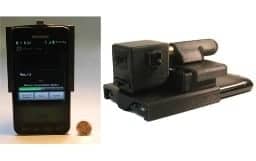A lightweight and field-portable device invented at UCLA that conducts kidney tests and transmits data through a smartphone attachment may significantly reduce the need for frequent office visits by people with diabetes and others with chronic kidney ailments.
The smartphone-based device was developed in the research lab of Aydogan Ozcan, a professor of electrical engineering and bioengineering at the UCLA Henry Samueli School of Engineering and Applied Science, and associate director of the California NanoSystems Institute. Weighing about one-third of a pound, the gadget can determine levels of albumin in the patient’s urine and transmit the results within seconds. Albumin is a protein in blood that is a sign of danger when found in urine.
Ozcan’s lab also developed the opto-mechanical phone attachment, disposable test tubes, Android app and software to transmit the data. The research was published this month by the peer-reviewed journal Lab on a Chip.
“Albumin testing is frequently done to assess kidney damage, especially for diabetes patients,” Ozcan said. “This device provides an extremely convenient platform for chronic patients at home or in remote locations where cell phones work.”
Patients at risk for diabetes, kidney disease and other ailments must regularly provide fluid samples — sometimes more than one a day — to monitor their health, which requires visits to labs or health centers.
The new device projects beams of visible light through two small fluorescent tubes attached to the device, one containing a control liquid and the other a urine sample mixed with fluorescent dyes. The smartphone camera captures the fluorescent light after it passes through an additional lens.
An Android application then processes the raw images in less than one second and the device transmits the test results to a database or health care provider. The test, which measures albumin concentration in urine, is accurate to within less than 10 micrograms per milliliter, according to the research, well within accepted clinical standards used in diagnosing conditions such as microalbuminuria, the excretion of albumin in urine.
The time it takes to conduct a test, including preparation of a sample using a small syringe to inject the urine into a fluorescent tube, is about five minutes. Ozcan estimates that the device — for which his lab also has developed an iPhone app — could be produced commercially for $50 to $100 per unit.
The first author of the research is UCLA postdoctoral researcher Ahmet Coskun. In addition to Ozcan and Coskun, co-authors include UCLA undergraduate students Richie Nagi, Stephen Phillips and Kayvon Sadeghi.
Financial support for the Ozcan Research Group comes from the Army Research Office, the National Science Foundation (NSF), the National Institutes of Health (NIH), the Office of Naval Research and the Presidential Early Career Award for Scientists and Engineers.
Ozcan, who holds more than 20 patents and has several pending patent applications related to optics and nanoscopy, joined the UCLA Engineering faculty in 2007. Since then he has been named one of Popular Science magazine’s “Brilliant 10” young innovators, and received the NIH Director’s New Innovator Award, the NSF CAREER Award, and young investigator career awards from both the ONR and ARO. In 2011, Ozcan won a Presidential Early Career Award for Scientists and Engineers, as well as the Early Career Achievement Award from SPIE, the international society for optics and photonics. He is a founder of the mobile microanalysis startup company Holomic LLC.
The UCLA Henry Samueli School of Engineering and Applied Science, established in 1945, offers 28 academic and professional degree programs and has an enrollment of more than 5,000 students. The school’s distinguished faculty are leading research to address many of the critical challenges of the 21st century, including renewable energy, clean water, health care, wireless sensing and networking, and cyber-security. Ranked among the top 10 engineering schools at public universities nationwide, the school is home to eight multimillion-dollar interdisciplinary research centers in wireless sensor systems, wireless health, nanoelectronics, nanomedicine, renewable energy, customized computing, the smart grid, and the Internet, all funded by federal and private agencies and individual donors.


